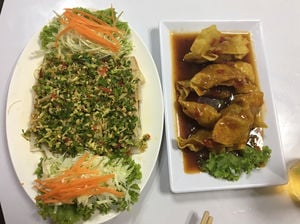
西方文化中廣泛流行的素食主義是一個相當新的現象,儘管並非沒有古老的先例。在許多亞洲文化中,素食主義已經存在了幾個世紀。素食主義的烹飪和文化方面可能被認為在某些亞洲文化中得到了更深入的發展。然而,保持素食生活方式對國內外遊客都提出了挑戰。
海鮮在許多國家美食中發揮重要作用,特別是日本、韓國、越南和泰國。肉類消費與高收入密切相關,因此,隨著亞洲國家現代化,肉類消費不斷增加。儘管不同流派和傳統之間的觀點有所不同,但素食主義的倡導與佛教和其他宗教密切相關。因此,許多亞洲城市的素食餐廳通常位於寺廟附近。
中國
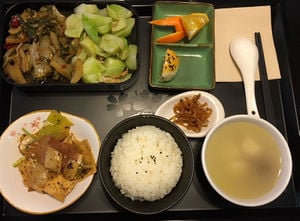
在中國歷史的大部分時間裡,肉一直被認為是一種奢侈品。由於人口眾多,糧食和蔬菜生產往往更集中於農業生產,並構成了該國糧食消費的大部分。中國-康乃爾-牛津計畫(「中國研究」)於1980-81年進行,記錄了「中國65個農村縣6,500人的飲食、生活方式和疾病特徵」。[1]康乃爾大學 T. Colin Campbell 對數據的解釋。發現較低的動物產品消費與較低的死亡率和其他健康指標有關。從此,中國迅速發展成為現代工業社會。家庭收入的增加導致肉類消費量的增加。從 1982 年到 2016 年,消費者平均每年吃肉量從 13 公斤增加到 63 公斤。[2]因此,中國的肉類消費量佔全球的28%,豬肉消費量佔全球的一半。
許多中國人,尤其是年輕的城市居民,正逆潮流而行,接受素食主義。中國的素食生活方式與佛教和道教密切相關,僧侶和俗人都信奉素食。各種宗教學校通常不認為素食主義是強制性的,但某些宗教學校可能比其他學校更強烈地鼓勵素食主義。由於雞蛋在生殖方面的作用,許多佛教徒也不食用雞蛋。有些學校也不鼓勵食用類似聖性飲食的辛辣/芳香蔬菜。與其他文化一樣,也有許多非宗教人士出於道德或其他原因實行素食主義。

乍一看,在中國吃素似乎有些令人生畏。儘管素食主義在中國有著古老的傳統,但許多中國人並不理解這種飲食背後的概念或原因。小規模餐廳老闆或食品供應商可能無法理解顧客要求菜餚中不含所有肉類的要求。由於其中包含肉末,因此不得不將菜餚寄回的情況並不少見。許多菜餚都是用動物脂肪或魚露烹調的。中餐通常包括多種菜餚,其中大多數包括蔬菜和肉類的混合。中國的素食者經常選擇吃肉,或為了實用而做出某些例外。素食餐廳在大城市很常見,但可能位置或營業時間不方便。
許多受歡迎的菜餚可以輕鬆適應素食者。番茄雞蛋(番茄雞蛋,fānqíejīdàn)價格便宜,易於製作,在中國各地都很受歡迎。它可以直接食用,也可以搭配米飯或麵條,或作為湯。羅漢齋(羅漢齋,luóhàn zhāi)可能是國際上最知名的中國素食菜餚,但在某些地區供應有限。魚香茄子(魚香茄子,yúxiāng qiézi)雖然名字如此,但不含海鮮,默認是素食。
豆腐(豆腐、dòufu)至少自漢代(約 2000 年前)就開始生產,是許多中國菜餚中的常見配料。中國的豆腐品種比西方國家常見的白色「絲豆腐」多得多。豆腐乾(豆腐乾,dòufugān)的質地較堅韌,使其成為許多中國菜餚中合適的肉類替代品。麻婆豆腐是很受歡迎的辣豆腐菜餚,無需通常包含的豬肉末即可製作。
印度
素食主義或許不像印度那麼根深蒂固。
印尼
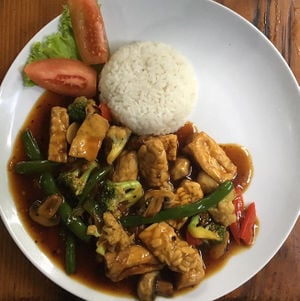
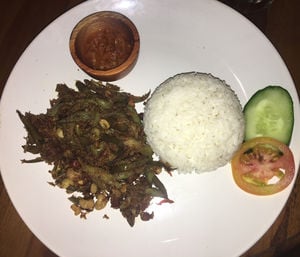
日本
日本料理以其海鮮菜餚而聞名。很難找到完全不含動物性產品的食物,尤其是魚湯(魚湯)。寺廟食物(shojin ryori)完全是素食。典型的素食/純素長壽飲食最早是在日本開發的。
韓國、韓國
作為一個半島國家,海鮮是韓國美食的重要組成部分。許多菜餚通常都是用魚醬或蝦醬烹製的,尤其是主食泡菜(김치)。燒烤、炸雞或生肉/魚 (회, hwe) 等肉類為主的餐點很受歡迎。不過,也可以很容易找到一些素食菜餚。 Kimbap(김밥,「韓國壽司捲」)通常用罐頭肉(Spam)製成,有時也用牛肉烤肉(불고기)或雞蛋製成,其中任何一個都可以排除。拌飯(비빔밥)通常配有蛋,也可能配有肉類,但可以排除肉類。冷麵(냉면,冰麵)可以用蔬菜湯代替肉湯製成。蔬菜餃子(소만두,so mandu;납짝만두,nabjjak mandu)在許多雜貨店都有販售。
寺廟的餐廳都是素食的。
馬來西亞

幾個世紀以來,馬來半島一直是世界貿易的重要焦點。隨著不同人群——原住民、馬來人、泰國人、中國人和印度人——定居在那裡,他們帶來了自己的飲食方式,為現代馬來西亞帶來了豐富多樣的烹飪傳統。與該地區其他國家一樣,米飯和麵條是主食,海鮮也發揮著重要作用。作為一個穆斯林占多數的國家,豬肉的作用較小,許多餐廳都會醒目地展示它們是否經過清真認證。歷代以來,海峽華人文化受到馬來文化的影響,產生了融合娘惹菜。在吉隆坡和檳城很容易找到各種民族美食的素食版本。在主要城市之外,除了印度餐館外,這變得更加困難。
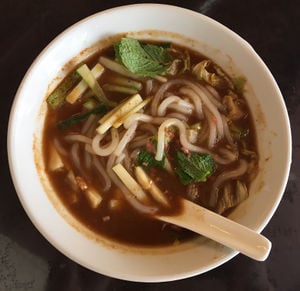
非官方的國菜椰漿飯由 5-6 部分組成:椰奶米飯、黃瓜片、烤花生、參巴醬(辣椒醬)和炸鳳尾魚,通常搭配一塊炸雞。素食餐廳使用仿鳳尾魚,並可能提供炸豆腐或蔬菜咖哩來代替雞肉。非素食餐廳通常願意提供不含肉類或海鮮的菜餚,但請注意,參巴醬可能是用蝦或魚製成的。叻沙是一種米粉湯菜,有多種地區和種族差異。最常見的版本有羅望子或椰子湯底。它可以與蝦或雞肉一起食用,但也可以用豆腐代替。
印度餐廳的菜單上通常有多種素食選擇,例如咖哩或塔利斯,大城市也有專門的素食印度餐廳。馬來西亞的印度菜往往以南印度菜為主,但偶爾也有北方風味。
泰國
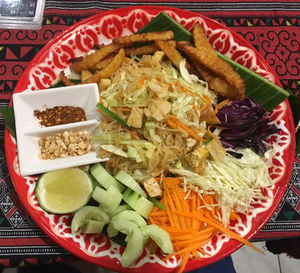
與許多其他民族美食相比,泰國菜提供以新鮮蔬菜為主的多種菜餚。儘管魚露、蝦和豬肉在泰式烹飪中很常見,但通常可以輕鬆排除它們。




